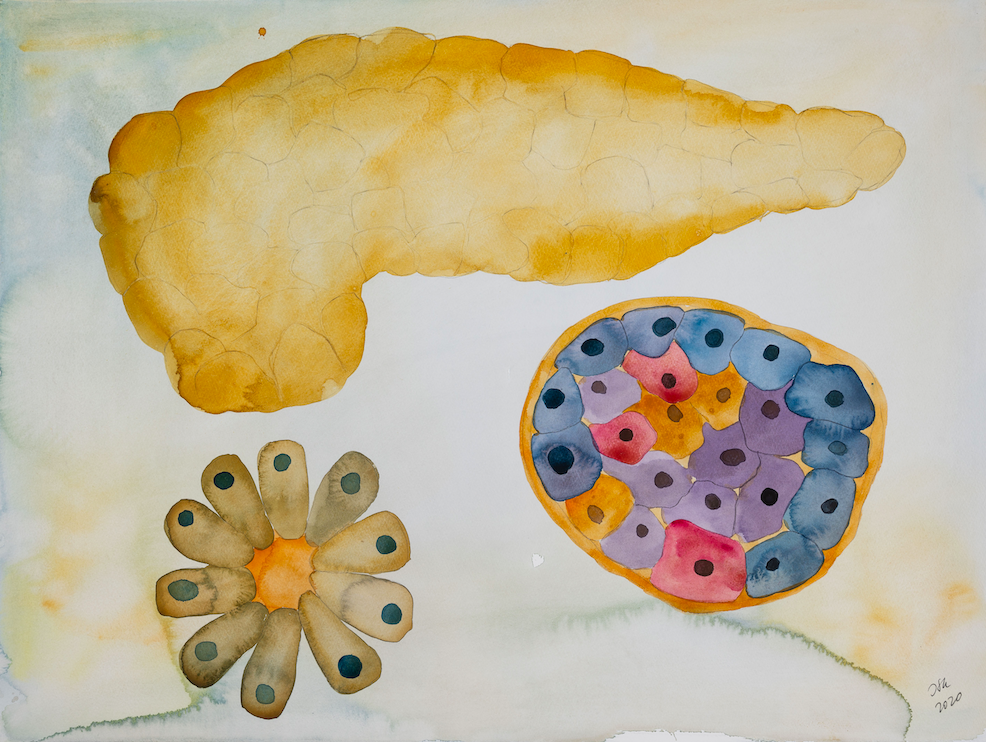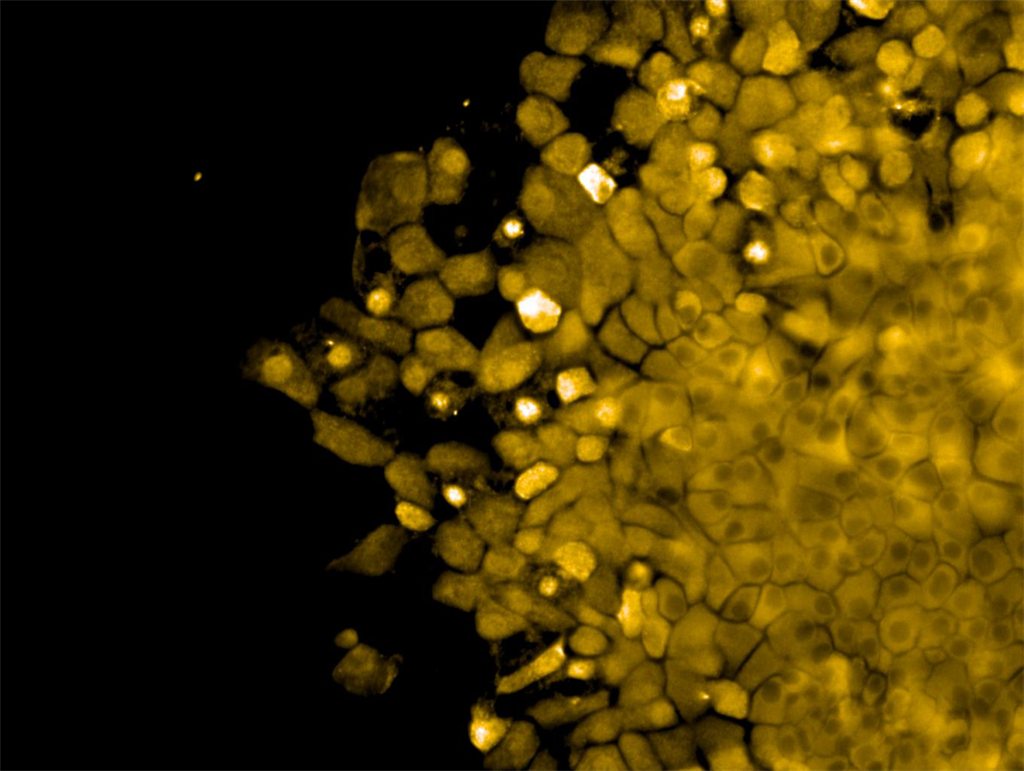Pancreatic cells

Biorelevant culture of pancreatic cells on Biolaminin substrates
The basement membrane formed next to the beta-cells contains alpha-4 and alpha-5 laminin isoforms
Endocrine pancreatic β-cells do not form their own basement membrane (BM). Instead, the β-cells require endothelial signals for their differentiation and for normal function (Lammert, 2003; Yoshitomi & Zaret, 2004). During late embryonic development, β-cells express high levels of VEGF-A that attract endothelial cells that, in turn, form the vasculature of the islets (Lammert, 2003; Nikolova, 2006). β cells in VEGF-A deficient mice have shown to have reduced insulin gene expression compared to fully vascularized control islets (Nikolova, 2006).
The vascular basement membrane formed next to the β-cells contains alpha-4 and alpha-5 laminin isoforms (Sigmundsson, 2018; Sixt, 2001). Immunostaining of fetal human pancreas show that laminin 411 is expressed (Petajaniemi, 2002), however, adult human islets are surrounded by a double BM containing both laminin 511 and laminin 411 but where the BM facing the human endocrine islet is suggested to only contain laminin isoforms 511 and 521 (Virtanen, 2008). Integrin expression analysis in isolated mouse islets highlights integrin β1, αV, and α6 as the most abundant transcripts (Sigmundsson, 2018) where all three bind α5-laminins. A study by Kantengwa et al. also demonstrates an important role of β1 integrins in islet cell attachment and spreading in vitro (Kantengwa, 1997).
Pancreatic islets cultured on Biolaminin 521 expand and remain functional
Sigmundsson et al. have developed a novel method to grow and maintain normoxic and functional islets which may significantly enhance the efficacy of islet transplantation treatment for diabetes (Sigmundsson, 2018). A key component of this method is the coating with biologically relevant laminins. Islets cultured in vitro on Biolaminin 521 adhere and spread to form layers of 1-3 cells in thickness while maintaining cell-to-cell contacts. The cells remained normoxic and functional for at least 7 days in culture. In contrast, spherical islets kept in suspension developed hypoxia and central necrosis within 16 hours. Mouse islets plated on Biolaminin 521 could be cultured in a serum-free mTeSR1 medium for an extended period of time. The flattened islets start robust cell proliferation after a lag period of approximately two weeks in a serum-free culture on Biolaminin 521. Approximately 20% of islet cells showed a co-expression of insulin and glucagon. Transplantation mouse islets cultured on α5-laminin-coated polydimethylsiloxane membranes for 3–7 days normalized blood glucose already within 3 days in mice with streptozotocin-induced diabetes.

Courtesy of Dr. Anna Domogatsakya, Karolinska Institutet, Sweden.
Laminin proteins stimulate beta-cell proliferation and insulin production in vitro
By using pancreas-specific laminins in cell culture, the biological environment of the pancreas can be mimicked, making pancreatic islet cells thrive. In a study by Dr. Doug Melton et al. they investigated which endothelial signals that promote β-cell proliferation and function. They show that laminin isoforms 411 and 511 stimulate β1 integrin signaling–dependent insulin production in vitro (Nikolova, 2006). The authors suggest that treating islets with these biologically relevant laminin isoforms prior to transplantation could help maintain insulin production until new capillaries are formed in transplanted islets (Nikolova, 2006).
Several studies have also revealed an essential role of cell-to-matrix interactions mediated by laminin 332 in the function of isolated pancreatic islet cells. Integrins a3β1 and a6β1 have been identified in rat pancreatic B cells (Bosco, 2000; Parnaud, 2006) and β cells cultured on a laminin 332-rich matrix spread out and secreted twice more insulin in response to glucose compared to cells cultured on plastic, poly-L-lysine (Parnaud, 2006). Furthermore, laminin 332 promote the proliferation of rat β-cells and protected the cells from apoptosis induced by pro-inflammatory cytokines (Hammar, 2004). In a follow-up publication by Armanet et al., the authors show that laminin 332 plays a physiologically relevant role in human islets since laminin 332 is expressed and secreted by human islets and since conditions inducing islet stresses, such as isolation procedure and cytokine exposure, enhance laminin-332 production (Armanet, 2009).
Biolaminin 411 is a potent differentiation inducer of insulin-producing cells
In a publication by Qu et al., laminin 411 was shown to act as a potent differentiation inducer of UC-MSC into insulin-producing cells (Qu et al. 2014). They showed that Biolaminin 411 induces the expression of pancreatic precursor markers and markedly up-regulate insulin expression, both at the mRNA and protein level. More importantly, the administration of Biolaminin 411-induced insulin-producing cells rapidly and significantly down-regulated fasting blood glucose levels, significantly reduced the HbA1c concentration, and markedly improved the symptoms and survival of type-1 diabetic rats.
Protocols:
Efficient differentiation of MSC-derived insulin-producing cells
Succeed with your application
-
Application note 003: Pancreatic cell differentiation and maintenance on Biolaminin substrates
Functional islets from stem cells with the help of Biolaminin
Open pdf -
Culturing functional pancreatic islets on α5-laminins and curative transplantation to diabetic mice
Sigmundsson K., Ojala J.R.M., Öhman M.K. Österholm A-M., Moreno-Moral A., Domogatskaya A., Yen Chong L., Sun Y., Chai X., Steele J.A.M, George B., Patarroyo M., Nilsson A-S., Rodin S., Ghosh S., Stevens M.M., Petretto E., Tryggvason K. Matrix Biology, 2018
Read more -
Laminin 411 acts as a potent inducer of umbilical cord mesenchymal stem cell differentiation into insulin-producing cells
Qu H., Liu X., Ni Y., Jiang Y., Feng X., Xiao J., Guo Y., Kong D., Li A., Li X., Zhuang X., Wang Z., Wang Y., Chang Y., Chen S., Kong F., Zhang X., Zhao S., Sun Y., Xu D., Wang D., Zheng C. Journal of Translational Medicine, 2014
Read more -
Instructions 001: Coating with Biolaminin substrates
Protocol and concentration calculations for coating cultureware with Biolaminin
Open pdf -
Instructions 011: Biosilk 3D scaffolds for differentiation and proliferation of hPSCs
Protocol for human pluripotent stem cell expansion, differentiation and organoid formation in 3D
Open pdf
Biolaminin Key Advantages
The vascular basement membrane formed next to the β cells in vivo contains laminin isoforms 411, 421, 511 and 521. Culturing of mouse and human islets on α5-laminins allow islets to spread, remain normoxic and functional. Transplantation of islets cultured on Biolaminin 521 normalizes blood glucose within 4 days in diabetic mice. α5-laminin and α4-laminins act as potent differentiation inducers of hPSC into insulin-producing cells.
Specific laminin isoforms are present in different tissue microenvironments and are essential for cell survival, proliferation, and differentiation. Biolaminin products allow you to imitate the natural cell-matrix interactions in vitro.
Our products have consistent composition and quality. This enables minimized variability between experiments and uniform pluripotency gene expression profiles between different cell lines.
All our matrices are chemically defined and animal origin-free, which makes them ideal substrates for each level of the scientific process – from basic research to clinical applications.
Numerous scientists have found our products and finally succeeded in their specific stem cell application. The power of full-length laminins incorporated into various cell systems is well documented in scientific articles and clinical trials.
Recommended products
-

Biolaminin 521 LN (LN521)
Human recombinant laminin 521
Biolaminin 521 LN is the natural laminin for pluripotent stem cells and therefore reliably facilitates self-renewal of human ES and iPS cells in a chemically defined, feeder-free and animal origin-free stem cell culture system. LN521 is animal origin-free to the primary level.View product -

Biolaminin 411 LN (LN411)
Human recombinant laminin 411
Biolaminin 411 supports many diverse tissue cell types such as cells from the pancreas and the vascular, immune, nervous, hematopoietic systems.View product -

Biolaminin 421 LN (LN421)
Human recombinant laminin 421
Biolaminin 421 supports several tissue-specific cell types such as endothelial cells and kidney cells, and has been suggested to be important for renal, synaptic and inflammatory functions.View product -

Biosilk 521
3D culture substrate
Biosilk 521 is a natural biomaterial made of spider silk and laminin 521 – a biocompatible 3D culture mesh for expansion and long-term differentiation of human pluripotent stem cells and for organoid formation of various cell types.View product

Talk to our team for customized support
We are here to help you in your journey.